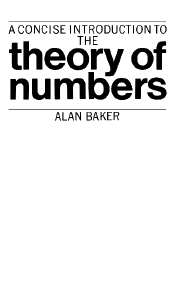Summary
Algebraic number fields
Although we shall be concerned in the sequel only with quadratic fields, we shall nevertheless begin with a short discussion of the more general concept of an algebraic number field. The theory relating to such fields has arisen from attempts to solve Fermat's last theorem and it is one of the most beautiful and profound in mathematics.
Let α be an algebraic number with degree n and let P be the minimal polynomial for α (see § 5 of Chapter 6). By the conjugates of α we mean the zeros α1, …, αn of P. The algebraic number field k generated by α over the rationals ℚ is defined as the set of numbers Q(α), where Q(x) is any polynomial with rational coefficients; the set can be regarded as being embedded in the complex number field ℂ and thus its elements are subject to the usual operations of addition and multiplication. To verify that k is indeed a field we have to show that every non-zero element Q(α) has an inverse. Now, if P is the minimal polynomial for α as above, then P, Q are relatively prime and so there exist polynomials R, S such that PS + QR = 1 identically, that is for all x. On putting x = α this gives R(α) = 1/Q(α), as required. The field k is said to have degree n over ℚ, and one writes [k: ℚ] = n.
Information
- Type
- Chapter
- Information
- A Concise Introduction to the Theory of Numbers , pp. 61 - 73Publisher: Cambridge University PressPrint publication year: 1984
